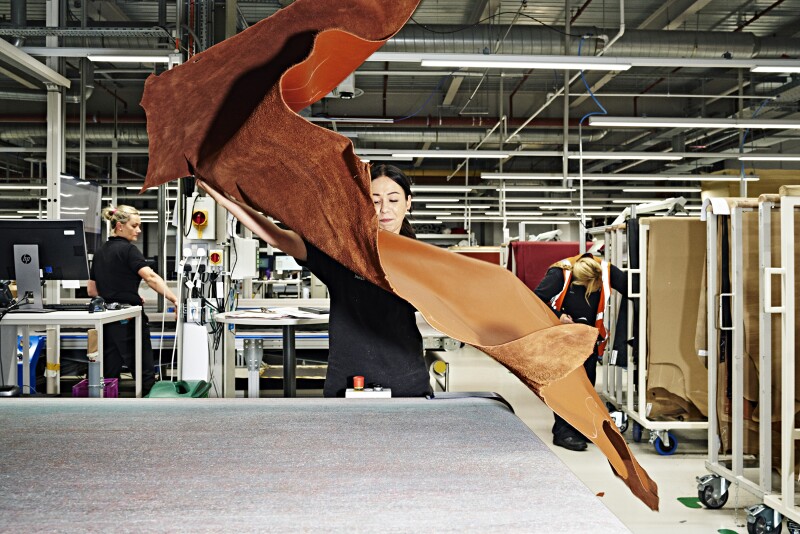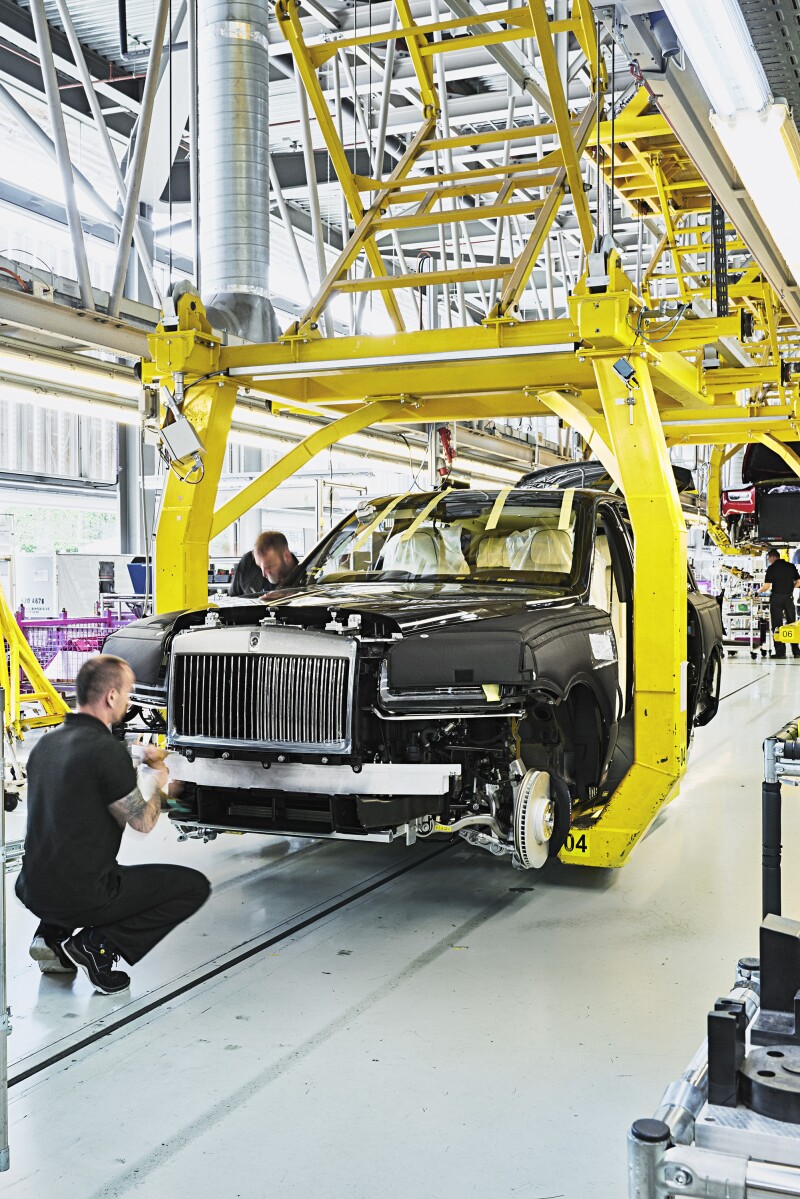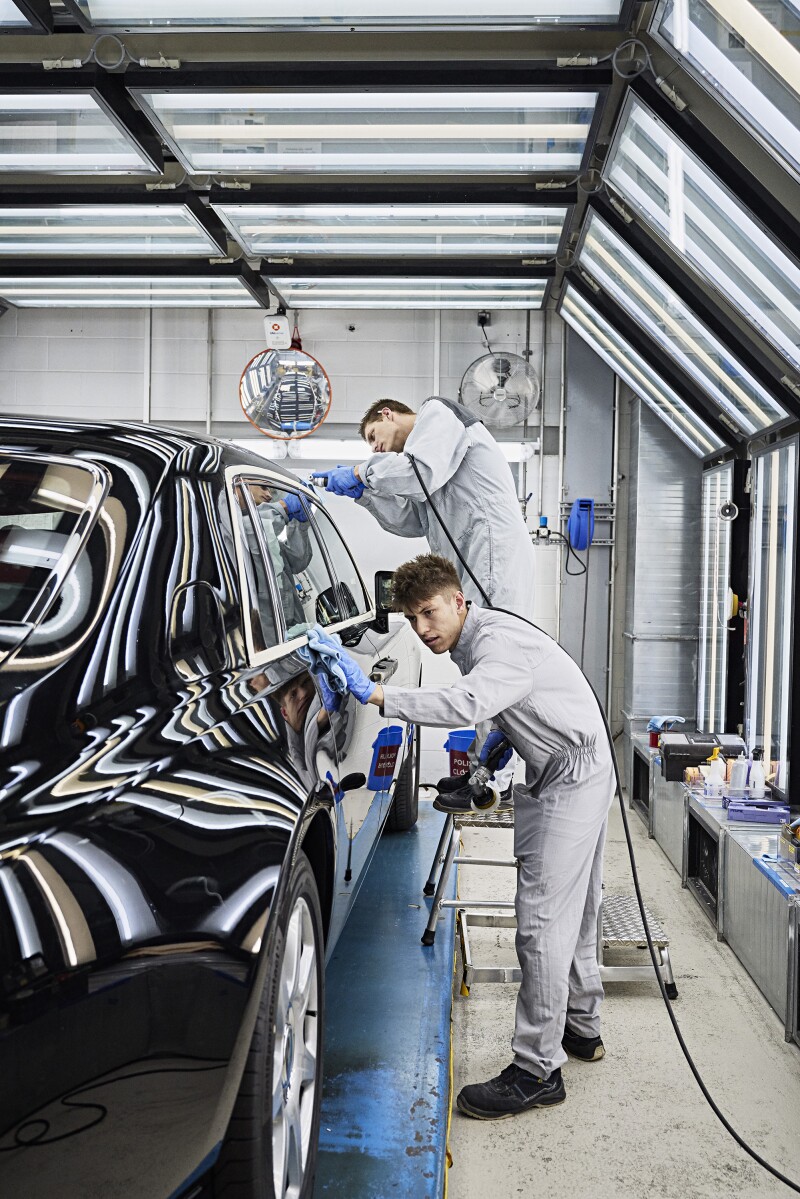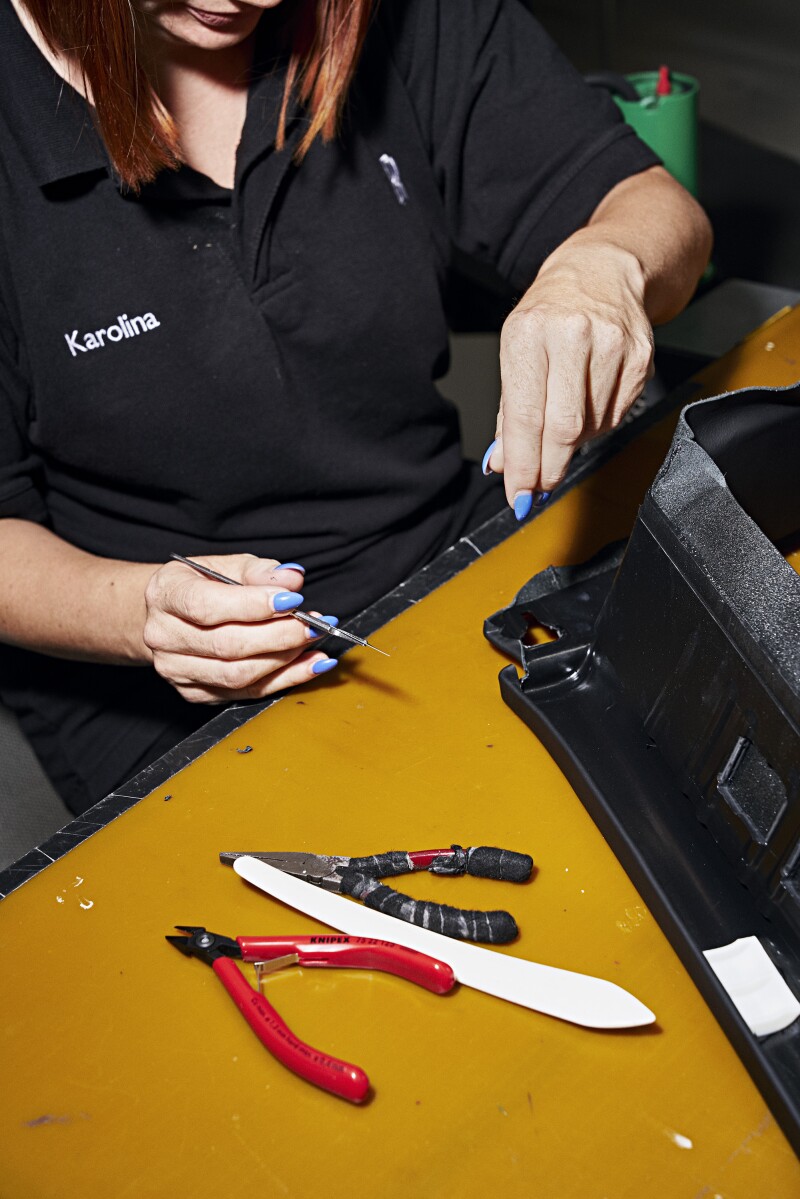I’ll confess: I’ve always wanted to know how it feels to be one of the nobility. And as I lounge in the leather backseat of a Rolls-Royce Phantom—the model that conveyed Meghan Markle to her wedding—with a capped chauffeur at the wheel, I’m getting my first taste. Our destination? The Goodwood estate in southeastern England, the present-day home of Charles Gordon-Lennox, the car-loving 11th Duke of Richmond and sixth Duke of Gordon—and the site of the Rolls-Royce manufacturing center, birthplace of the Phantom.

A worker prepares to cut a piece of leather for an interior.
Photo by Harry Mitchell
Beech and oak trees parade past the Phantom’s tinted windows as we drive through the vast wooded estate. We pass the Duke’s stately house—and his sculpture park and his private motor-racing circuit—to reach the much more modern Rolls-Royce headquarters. Built in 2003 on 42 acres of land leased from the Duke, the compound is low profile but impressively sustainable, with floor-to-ceiling glass walls that maximize natural light, and an undulating green roof that provides insulation and absorbs rainwater. (The headquarters was designed by Sir Nicholas Grimshaw, the celebrated architect of England’s Eden Project, the largest indoor rain forest in the world.)
What happens inside the building, however, hasn’t changed much since Rolls-Royce was founded in 1906. The cars are, to a great extent, still designed and made by hand, and almost all are bespoke creations, explains Michael Bryden, one of Rolls-Royce’s top designers, who meets me inside. (And no, I don’t open a single door for myself along the way.) “The mentality is complete personalization,” Bryden says. “You’re focusing on one customer and making their dream car.”

Rolls-Royces, England’s most celebrated vehicle, are crafted by hand.
Photo by Harry Mitchell
Bryden is one of 1,800 staff members working at the manufacturing plant. (It is considered terrifically uncouth to use the f-word: “factory.”) He shows me around the atelier—the design showroom for clients—where exquisite wood and silk samples are temporarily upstaged by an entire alligator skin, draped across a desk. This side of the headquarters is built for theatrics. Clients sign for their purchase in a room with the feel of a club lounge, from its cocktail bar to the vintage safe that contains the contracts. They finally see their car in the mini theater, where it’s revealed on a podium to accompanying sound and lighting effects.
We cross an enclosed walkway to reach a larger building where the unseen magic happens. Here, the car’s basic endoskeleton—called the monocoque—makes its way through 44 separate stations until every component, from wheels to doors to windows, has been painstakingly installed by hand. The engines themselves arrive from a separate facility, ready to be attached to the drive shaft at the romantically named “marriage station” in the middle of the assembly line.

Color swatches in every possible shade are displayed at the Rolls-Royce manufacturing plant.
Photo by Harry Mitchell
Here, there is great pride in the absence of robots. Walking the plant’s floor, we observe the entire process. I watch as, at one station, male and female mechanics in smartly monogrammed polos surround the chassis, tightening individual nuts and bolts with their digital wrenches. At a station farther down the line, a mechanic fixes the Rolls-Royce’s unmistakable grille in place; near the end of the line, its famous flying lady, the Spirit of Ecstasy, is fitted onto the hood. Each team has a precise time period to complete their task before they must push the vehicle, by hand, on to the next. The emphasis here is on precision and perfection rather than quantity. (In 2018, Rolls-Royce manufactured 4,107 vehicles. Ford sold 254,082 cars in Britain that same year.)
Next, we explore the light-filled workshops off the main floor, where specialist leather and marquetry workers handle materials rarely used in the automotive industry—sustainably sourced acacia koa wood, stingray leather, ostrich skin—creating the interiors that will ultimately be fitted on the line. In one section, a platoon of textile workers sits at sewing machines stitching seat covers to order; in another, a designer hand-illustrates an eagle for a customer who wants it embroidered onto their paneling.

A Rolls-Royce gets its wheels.
Photo by Harry Mitchell
Rolls-Royce designers are used to accommodating unusual demands, whether it’s inventing a paint color to match a favorite lipstick or studding a dashboard with bona fide diamonds. But the cars would be nothing without their world-famous engines. One man was ultimately responsible for these: Henry Royce. Born poor in England in 1863, he worked from the age of nine, selling newspapers and delivering telegrams until an apprenticeship with the railways unleashed his passion for invention. The lightbulb base he created—known as the bayonet cap—is still in use in most British households today.
It was his partnership with Charles Rolls, a daredevil aristocrat and friend of the Wright Brothers, that made his name. Royce had just built his first automobile when he was introduced to Rolls in 1904 by a mutual friend, Henry Edmunds. Rolls was so impressed by the vehicle that he asked Royce to manufacture an exclusive line of cars. When they launched their first model in 1907, the Silver Ghost smashed all previous reliability records, including a famous test run that covered more than 14,000 miles (shuttling back and forth between London and Glasgow over the course of several weeks) without an involuntary stop, unheard-of in those pioneering days of the motor vehicle. And with Rolls’s connections to the gentry, both the Silver Ghost and the cars that followed—the Phantom, the Wraith—became must-haves for the British elite.

Rolls-Royce employs 1,800 staff members at the manufacturing plant.
Photo by Harry Mitchell
Not merely posh status symbols, the cars have always been able to traverse nearly any terrain. In the 1920s, Lawrence of Arabia crossed the Sinai Desert in a convoy of armored Rolls-Royces. Indian maharajahs drove them through the jungle. In Australia, farmers used them on sheep stations in the outback. “The cars were so well built and so resilient and strong that they could do that,” Bryden says. “They still are.”
Case in point: Rolls-Royce recently launched its first-ever SUV, the Cullinan, which has a V12 engine and can handle snow, mud, rough roads, and submersion in nearly two feet of water—all while keeping your champagne cold. (That’s what the bottle refrigerator is for.) Admittedly, with all that engineering, Rolls-Royce cars have a heavy footprint. The Cullinan weighs nearly three tons and can only manage 20 miles per gallon on the highway. But then, I tell myself, I wouldn’t use my Rolls-Royce to nip to the shops and back. I’d keep it for special occasions, those moments when I wanted to feel like a duchess.

Rolls-Royce designers are used to accommodating unusual demands, whether it’s inventing a new paint color or studding a dashboard with diamonds.
Photo by Harry Mitchell
How to Experience England’s Motor History Only potential customers can tour the Rolls-Royce headquarters, but anyone can experience Britain’s motoring heritage at the Goodwood estate. The Duke’s motor-racing circuit is open throughout the year for driving experiences (say, joining a professional driver in laps around the course) and hosts two of the most stylish meets in the country. The Festival of Speed, in July, is a four-day carnival of motorsport based around the UK’s most famous time trial, while the Goodwood Revival in September celebrates the golden era of the ’40s, ’50s and ’60s with heritage races in classic cars. (Spectators are encouraged to dress in the style of the era.) Stay at the four-star Goodwood Hotel on-site, where you can take in one of the weekly horse races on its legendary racecourse, try out its golf courses, learn how to shoot, or watch a cricket match. From $130.
>>Next: These Talented London Artisans Are Keeping the City’s Craft Tradition Alive












